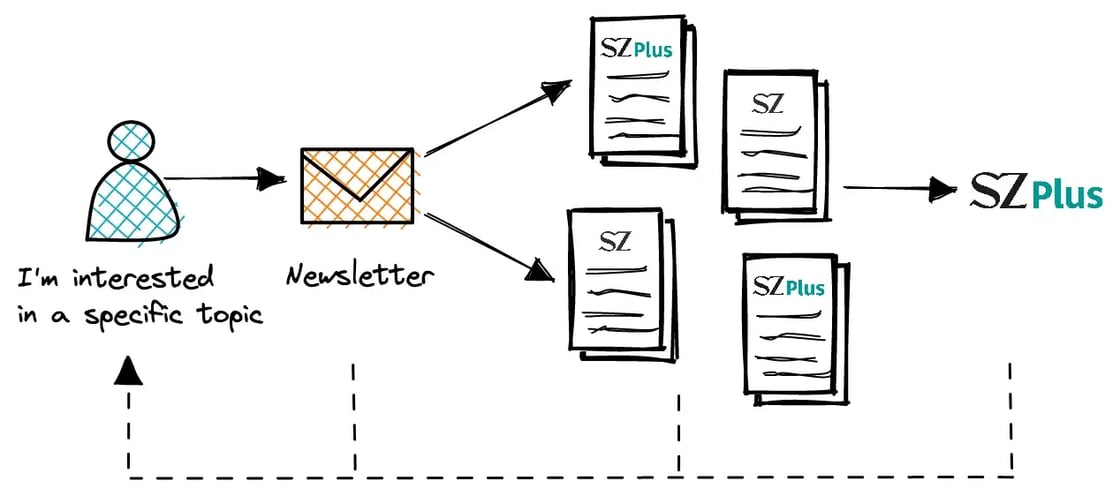

You're reading The Audiencers' newsletter #6, sent out on January 25th, 2023. To receive future newsletters straight to your inbox every two weeks, sign up here.
2023, the year of the registration wall?
“Our anonymous users consume 3 articles a month, registered users consume 33, and subscribers 185… getting high value readers to register is our priority over the next 12 months.” – Jo Holdaway, The Independent
From first-party data collection and increased revenue through advertising, to higher frequency of visits and 2-10 times greater propensity to subscribe… converting an anonymous user into a registered member is going to be a priority for a great number of publishers this year, not just The Independent.
In our Newsletter #6:
- Inspirations: 7 lessons to learn from 7 different subscription businesses
- Ask the experts: how can you make newsletters valuable in a reader revenue model?
- Operations: why you should move from a research-first to a decision-first approach to user research, just like The Conversation
- Recommendations to add to your reading list: from The Audiencers and friends
Inspirations
7 lessons for publishers from 7 different subscription businesses
From bicycles & movies to music & software, we all use these on a subscription basis nowadays.
And despite being the ‘original’ subscription businesses, publishers can learn a lot from these other industries as ex-DIE ZEIT, now consultant Lennart Schneider summarized for The Audiencers last week…
Adobe made the success of their customers their primary goal.
BookBeat filter out bargain hunters by ending a subscription trial immediately upon cancellation.
Babbel has increased their minimum commitment from 1 to 3 months, aiming to increase CLV and allow more time for the user to build a language-learning habit.
Steady has a ‘community first’ approach: whilst most members don’t pay for content, they feel part of a community of like-minded individuals, making them more likely to pay for content in the future.
Urban Sports Club has prioritized user onboarding, asking ‘what does the customer actually intend to do with the product?’
Blinkist’s CEO believes maximum transparency is the key to their successful ordering process – the landing page, steps and deadlines are listed in detail, and customers are informed before the free trial period of seven days expires that the subscription will soon cost money.
Swapfiets, the bike subscription service, have made customer service part of their product, focusing on just a few core products that prioritize customer service. This is why they spend a lot of time considering and testing potential new products.
Find the full details of each ‘lesson to learn’ on The Audiencers.
Ask the experts: how can you make newsletters valuable in a reader revenue model?
“Are newsletters really valuable in a reader revenue model?”
It’s a question brought up by a reader, and one that caught my attention. Whilst there’s been a lot of buzz around newsletters over recent years, and plenty of informative content on how to make them a success, there’s been a lack of focus on the real value of newsletters. And by value, I mean money. Reader revenue. Not simply engagement or traffic acquisition – are newsletters really valuable to a reader revenue model?
For consultant, Alastair Lewis, the key is to define a clear goal and purpose of each individual newsletter:
There is not a ‘one size fits all’ approach. You need to tailor the newsletter to the readers and to the purpose you have for the specific newsletter ( i.e. drive traffic back to site, enhance the value of subscribers, promote an event, acquire registrants, convert readers into subscribers, or for commercial reasons). If you are clear on that purpose, you can make sure it is written, designed, timed, curated etc in the most effective way for achieving that purpose.”
Alastair Lewis, Owner of Quested Consulting
To put this into context, Público’s João Pedro Pereira, Newsletter and Digital Projects Editor, shared how they’ve done exactly this, building newsletters around a specific goal and measuring success accordingly:
We have three broad groups of newsletters depending on what the goals are: traffic generation; engagement and brand recognition; subscriber acquisition and retention. In some cases, there may be some overlapping, of course – the number of newsletter subscribers and open rates are relevant across the three groups for instance.
Specially in traffic-oriented newsletters, clickthrough rates are also very important, as are the number of pageviews and average time of newsletter-generated visits.
Subscriber acquisition or retention is much trickier to assess. We have a few subscriber-only newsletters, and we monitor their success as measured by the traditional metrics of subscriptions and opening rates. We also monitor what links users click and whether those pages are part of the user’s journey to become a subscriber.
Finally, we take into consideration less measurable factors, such as whether newsletter readers email or engage in another way with the journalists writing them.”
Whilst at Süddeutsche Zeitung, the secret to gaining value from their newsletter lay in finding a balance between promoting free vs premium content:
We started linking more paid content in our newsletters where it made sense. That sounds easy, but the question is where and how much? We came up with a few criteria: First, it makes sense for topics where we also have sufficient exclusive content and great journalism for which subscribers are likely to pay. Second, it depends on the user’s need that a newsletter is aiming to satisfy — if it’s more about news then paid content plays a less important role than if it’s about inspiration, education or going deeper. For some topics, we even restructured the newsletter so that it serves more as a frame to one specific paid article that is at the center of this newsletter — basically, a paid content newsletter — it’s still a free newsletter but it centers around paid content.”
This had led the German publisher to an average of 8% of overall paywall conversions coming from newsletters, an impressive figure that shows the value of this medium for subscriber acquisition.
For Andy Griffiths, newsletter industry veteran, and founder and editor of Champion Newsletters, this links to the visibility of your paid model, bringing it in front of the reader the right number of times:
If the reader revenue you’re after is a subscription, the truth is that repetition is the best way to maximize revenue. I’ve always worked on the rule of thumb that people need to view an advert an average of 7 times before they respond with a buying decision (if they are buyers in the first place). You have to ask many times to get a sale but this needs to be done judiciously with the right balance in the newsletter between content and promotion, to avoid frustrating the reader. A balance of 4 content to 1 promotion is a good starting point, but you may find you can ramp up promotion to a greater level without generating fatigue, especially if your free content is compelling and needed.”
Find more advice and best practices from The Wall Street Journal, The Inbox Collective’s Dan Oshinsky and others in our full article on The Audiencers.
Operations
Why should you move from a research-first to a decision-first approach to user research like The Conversation?
We’ve all seen it: a team wants to know more about its users or customers so it scrambles to create a survey with lots of questions. It hustles to get respondents, eventually compiles the data it gathered, and presents them as a massive slide deck. And it hopes that among the plethora of collected data, it will find some potentially interesting information. This is the research-first approach:

But this often leads to problems that don’t support effective user research:
- Few (or no) actions come out of the research
- Lack of decisions prior to research means you don’t collect the right data
- You’ll likely over-collect data to cover all possibilities, which is a waste of resources for both your team and your users
An alternative approach can, however, lead to better user research, one that’s premised on informing actions:

The Conversation has been using this new method for the past year to build new products such as their climate action newsletter, and landing page dedicated to COP26 coverage.
Head of Audience Insights, Khalil A. Cassimally, shares exactly how they’ve put this new theory into practice (and why you should do the same) in his article.
In-house content to read…
- 4 essentials for brands to turn content into business
- How Le Figaro limits password sharing amongst subscribers
- Registration Walls: 18 benchmarks to better convert users into members
…and recommendations from elsewhere
- 8 charts that you need to see from Reuters predictions for 2023
- 5 lessons from FT Strategies for businesses investigating dynamic pricing (something The Atlantic recently introduced)
The Audiencers’ newsletter: from professionals to professionals
Sign up to our newsletter – real-life examples, expert points of view and inspirations from publishers around the world to help you do your job better. Sent every two weeks.



